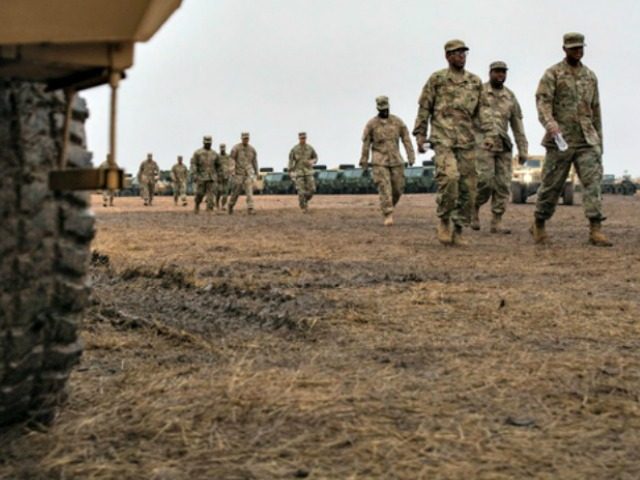The Pentagon announced Monday that Acting Defense Secretary Patrick Shanahan has authorized sending anothe 1,000 troops to the Middle East, following alleged attacks by Iran on foreign vessels in the Gulf of Oman.
Shanahan said in the statement:
In response to a request from the U.S. Central Command (CENTCOM) for additional forces, and with the advice of the Chairman of the Joint Chiefs of Staff and in consultation with the White House, I have authorized approximately 1,000 additional troops for defensive purposes to address air, naval, and ground-based threats in the Middle East.
Just over two weeks ago, the Pentagon authorized sending 1,500 troops to the Middle East, also in response to a request from McKenzie, over alleged increased threats from Iran. Those troops consisted of a Patriot battalion to defend against missile threats, drone aircraft, an engineer element, and a fighter aircraft squadron. This was on top of sending the USS Abraham Lincoln and a bomber squadron to the region.
Those deployments came after Centcom warned there were threats against U.S. troops in the region, the sabotage of four vessels, an armed drone attack on Saudi pumping stations, and a rocket attack in Iraq near the U.S. embassy.
Shanahan referenced recent attacks on foreign oil tankers in the Gulf of Oman as justification.
“The recent Iranian attacks validate the reliable, credible intelligence we have received on hostile behavior by Iranian forces and their proxy groups that threaten United States personnel and interests across the region,” he said.
On Thursday, two oil tankers — one belonging to Norway and the other to Japan — were attacked in the Gulf of Oman, allegedly by limpet mines deployed by Iran.
Secretary of State Michael Pompeo later that day attributed the attacks to Iran, and Centcom put out imagery and a video of what the command said were Iranian sailors retrieving an unexploded mine from the Japanese tanker. On Monday, it released more imagery.
Iran denied carrying out the attacks, but British Foreign Secretary Jeremy Hunt also said the attacks were “almost certainly” carried out by Tehran. A BBC reporter also tweeted a UK Foreign Office source had said, “We strongly agree with the US assessment,” according to Reuters.
The Sunday Times reported that the United Kingdom was sending 100 Royal Marines to the Arabian Gulf to protect Royal Navy and merchant shipping in the area.
A Defence Ministry spokesperson denied the deployment was related to Iran: “This is a pre-planned training deployment and is in no way related to the ongoing situation in the Gulf of Oman.”
The attacks began after the U.S. in April designated the Iranian Revolutionary Guard Corps a terrorist group and announced that it was ending waivers on sanctions on countries still buying oil from Iran, ending a major source of revenue.
The moves are part of the administration’s “maximum pressure” campaign to get Iran to come back to the negotiating table and renegotiate a strong Iran nuclear deal. Former Obama administration officials have launched a media campaign opposing the maximum pressure campaign and claiming the Trump administration wants war with Iran.
Trump administration officials say they are not seeking war with Iran.
Indeed, Shanahan reiterated the U.S. position that it does “not seek conflict with Iran” as he announced the deployment.
“The action today is being taken to ensure the safety and welfare of our military personnel working throughout the region and to protect our national interests,” he said.
“We will continue to monitor the situation diligently and make adjustments to force levels as necessary given intelligence reporting and credible threats,” he said.
Sen. Tom Cotton (R-AR), an Iran hawk who is close to the White House, put out a statement supporting the troop deployments.
“This kind of deployment is a prudent measure to build up our force protection posture at some of our permanent bases in the region like in Qatar and Bahrain where we have thousands of sailors and airmen based, as well as some of the contingency forces we have in places like Iraq,” Cotton said on Fox News on Monday.
“It’ll also help with surveillance in the Persian Gulf, in the Strait of Hormuz, and the Gulf of Oman against the kind of unprovoked attacks on commercial shipping on the high seas that Iran conducted last week against those two tankers, or they conducted in a port last month against four different tankers,” he said.
Cotton pushed back against the idea that the Trump administration’s strategy has put the U.S. on a “collision course” with Iran. He said:
If the United States and Iran are on a collision course, it’s only because Iran continues its 40-year, low-level war against the United States to the point of provoking retaliatory military strikes. Let’s remember the Ayatollah seized power in 1979 and immediately invaded sovereign American soil, our embassy in Tehran, and held our fellow citizens hostage for 400 days.
Also, in 1987, 1988 Iran did exactly the kind of thing they are doing now, attacking commercial vessels in the Persian Gulf and in the Strait of Hormuz to the point that Ronald Reagan had to conduct retaliatory military strikes against the Iranian navy and their oil facilities. What Iran did last week warrants such retaliatory military strikes. It’s up to Iran whether they want to behave like a civilized, normal nation or whether they want to continue to conduct these kind of terrorist attacks.

COMMENTS
Please let us know if you're having issues with commenting.